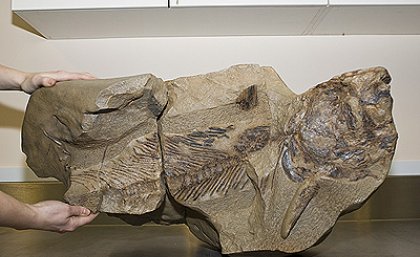
The fossil of a large, fast-swimming predatory fish, similar to the modern day Indo-Pacific tarpon, has been found near Isisford, central-western Queensland.
The new fossil comes from the same locality that produced the skeleton of Isisfordia duncani, the world’s first modern crocodilian, and is estimated to be between 98 and 95 million years old.
The Isisford tarpon was found in the mid-1990s by then local grazier Ian Duncan.
The beautifully preserved, articulated skeleton was entombed in a large sandstone boulder, close to where Mr Duncan found the first pieces of Isisfordia.
“I’d been poking around in the creek bed looking for more pieces of the croc when I came across a large bolder,” Mr Duncan said.
“There weren’t any bones sticking out, but it had the right kind of look about it, so I thought I’d try and wedge it open with my crowbar.”
The boulder split along the plane of weakness created by the skeleton, and opened to reveal the beautifully preserved fossil inside.
The preserved portion of the fish includes the back of the head and front half of the body.
The complete fish is estimated to have been over a metre in length.
The fossil was prepared and studied at The University of Queensland by a team led by Dr Steve Salisbury from the School of Biological Sciences.
“This is the first fossil of a bony fish to come from the Winton Formation,” Dr Salisbury said.
Based on comparisons with other fossil and living fishes from around the world, Salisbury and his team believe the new Isisford fish belongs to a group known as elopomorphs.
“Elopomorphs are large predatory fishes that can attain lengths of over 2.4 metres," he said.
They are typically found in tropical areas, and prefer shallow, sandy habitats around islands and the coast,” said Rodney Berrell, who is part of the team that has been studying the fossil.
The best-known Australian tarpon is Megalops cyprinoides, the ‘oxeye herring’ ‘bony mullet’ or ‘Indo-Pacific tarpon’.
The only other fossil tarpon from Australia is the slightly older Flindersichthys, which is known from fossils discovered further north, near Richmond, Hughenden and Boulia.
“Unlike Flindersichthys, which lived in the epicontinental Eromanga Sea, the Isisford tarpon was a freshwater fish,” Mr Berrell said.
“It’s possible that its marine ancestors became trapped in the inland river systems after the seaway retreated.”
The team believes that the discovery of this fish at Isisford indicates that the river in which it lived was large and fast-moving, perhaps similar to the modern Amazon.
“These are big, powerful fishes that need room to move,” said Dr Salisbury said.
“The environment around Isisford 98-95 million years ago must have quite different to the lakes and billabongs that have produced other fossils from the Winton Formation.”
“Together with the crocodilians, these fishes are helping us piece together aspects of the unique fauna that inhabited this part of Queensland during the later part of the age of the dinosaurs.”
A new display featuring the Isisford tarpon opens at the Outer Barcoo Interpretation Centre in Isisford on Saturday 17 July at 10.30am.
The Outer Barcoo Interpretation Centre is open daily from 9-5. (07 46 588 411)
Media: Dr Steve Salisbury (0407 788 660).
For more information on the Isisford fauna: www.uq.edu.au/dinosaurs




